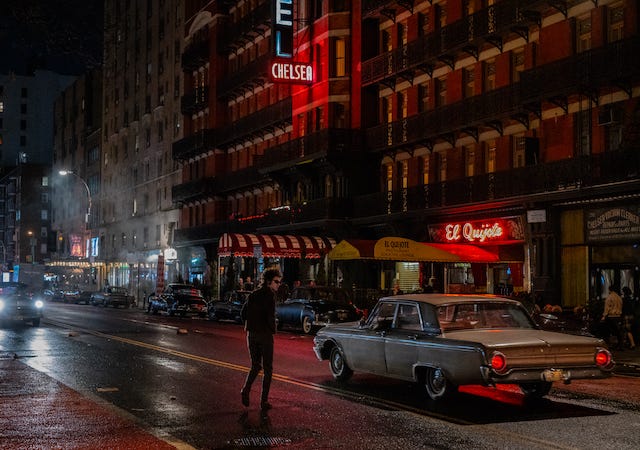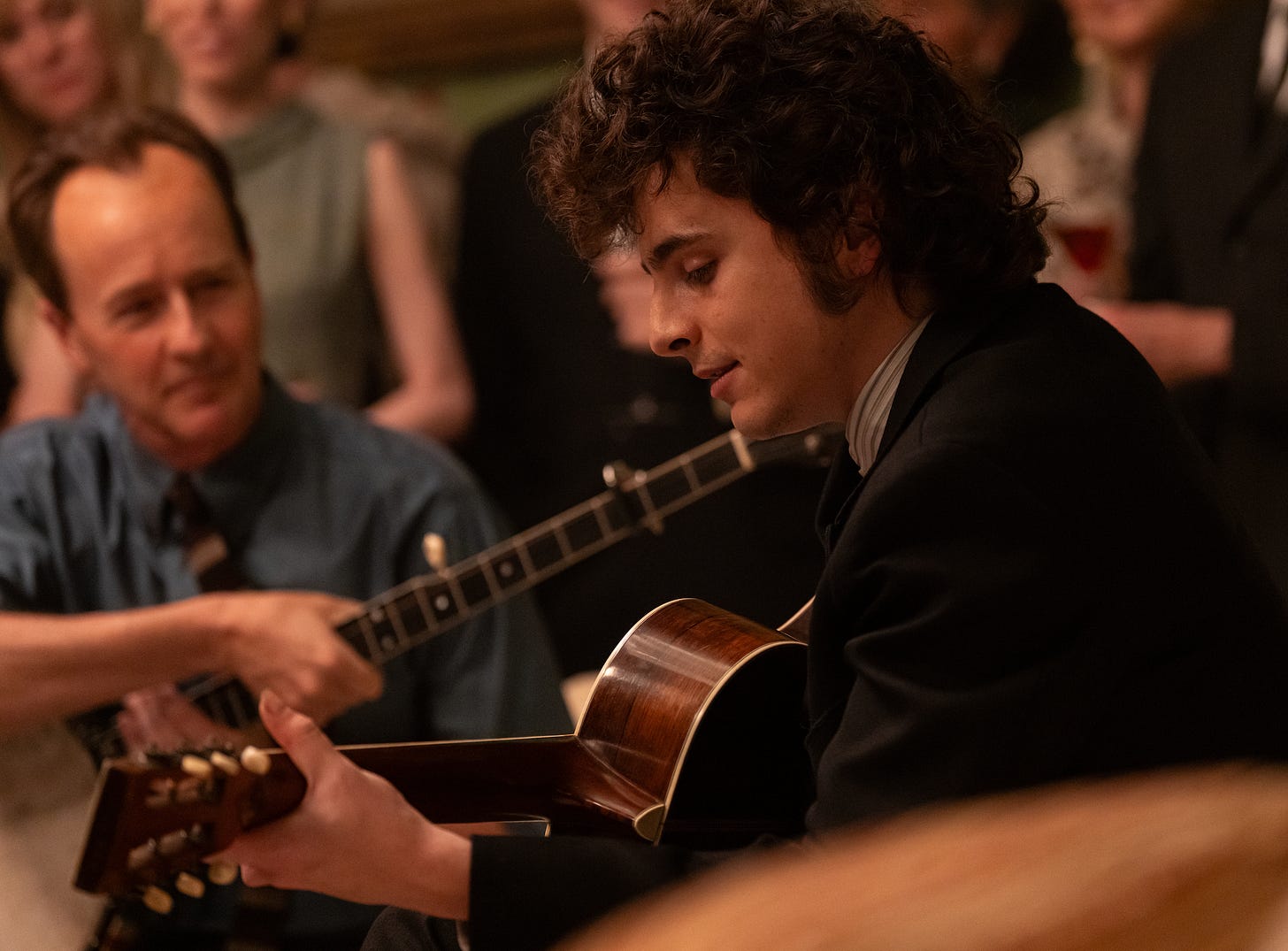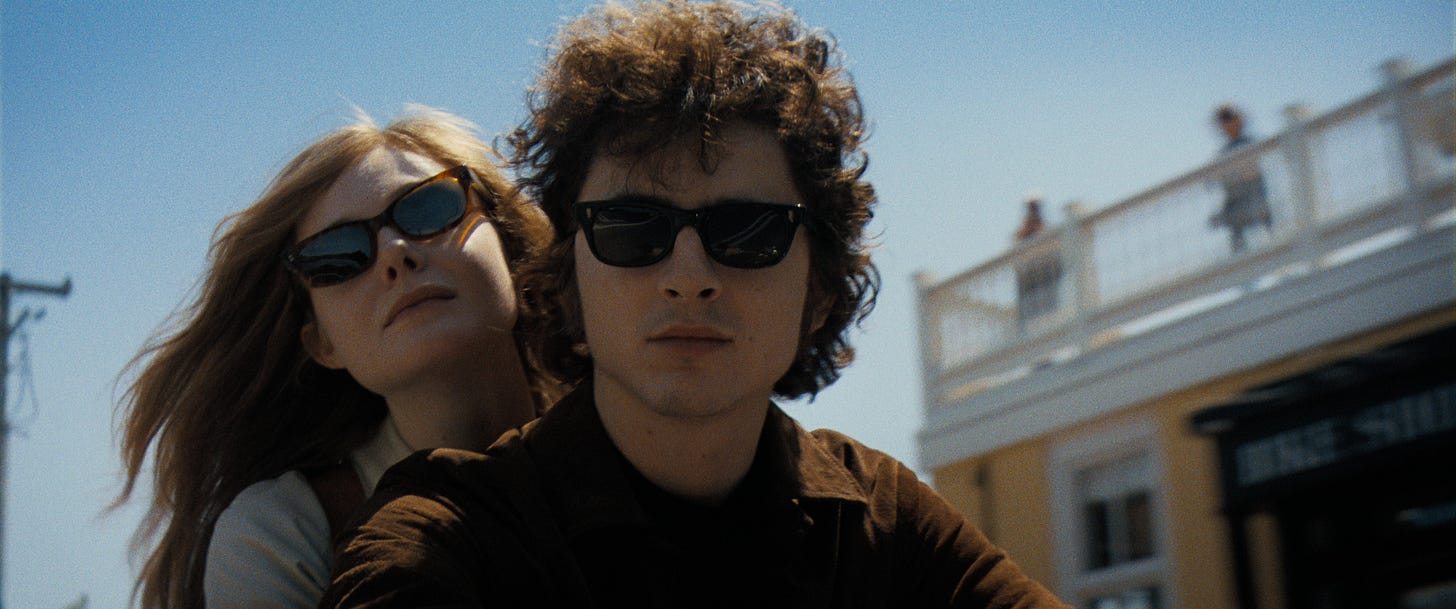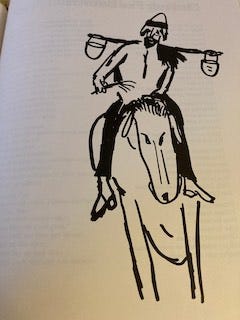Just See It Twice, It's All Right
Season 7, #2: Some Daytalking about James Mangold's A Complete Unknown (2024)
And you figured you failed in yesterday’s rush / When you were faked out an’ fooled while facing a four flush…1
LET’S START WITH “THE bucket.”
It wouldn’t let me go.
It was the sound of a pail being kicked into the hall by the hospital worker—so jarring yet so commonplace—that, for me at least, augmented … something.
But when you see a young Bob Dylan (played by Timothée Chalamet) skulking around the corner just as that happens, looking for the hospital room where his idol Woody Guthrie lies in bed being treated for Huntington’s disease, then you know it means something.
James Mangold’s A Complete Unknown (in theaters now) just might be a masterpiece, I don’t know. But I will admit it’s a very, very good film. And it’s not just a “biopic” of musical legend Bob Dylan’s origin story in New York City in 1961. It’s an incredibly taut, occasionally funny, often emotionally moving ensemble piece, with each character playing off a canvas that is the glittering and ragged mosaic that is Bob Dylan.
But that scene with the hospital worker and the bucket? Blink and you’d miss it.
Like the marvelous script by Mangold, Jay Cocks, and based on the book Dylan Goes Electric! by Elijah Wald, there’s a setup and a solid payoff.
Man in the Street
I’ve sung you my song, ain’t very long / ’Bout an old man who never done wrong / How he died no one can say / They found him dead in the street one day.2
Any solid film I’ve ever seen made me think immediately after I saw it. I might forget the details, but a feeling stays with me—a lingering nugget of wonder.
A Complete Unknown had that nugget in spades.
I didn’t realize it hours after seeing it, but with nine hours of post-holiday sleep, worry and dread piled upon guilt and regret, I awoke the next day with nothing but reverence for the two hours I’d spent in the darkened theater on St. Paul’s Grand Avenue, even though it was early afternoon on Christmas Day.
The film Mangold made (with so many others) was solid because it had a skeleton. Behind that skeleton was a strong spine. Attached to that spine and skeleton nerves and muscles rippled through (emotion) and fired neurons within itself (connection) and swelled into waves of music and, well … mysteries.

It begins with a hitchhiker being let out in downtown Manhattan, 1961. But he’s a man on a mission. He’s brought little with him from wherever he came, but he’s open to the street. The street is his internet, his network, his hallways to smell through…
Showing a clipping about his idol Woody Guthrie to a diner patron, he’s approached by another guy (Dave Van Ronk, played by Joe Tippett) who directs him to Greystone Park Psychiatric Hospital in New Jersey, where our hero immediately goes.
Look, I got it right away. This is almost “son seeking father while seeking future over past.”
But we have to confirm that first.
Bringing a Shovel to the Teaspoon Brigade
Hey Woody Guthrie, but I know that you know / All the things that I’m a-sayin’ an’ a-many times more…3
So, is Pete Seeger playing the nursemaid for the past (taking care of Woody Guthrie at the hospital) while, oddly enough, this young kid fresh from the road is somehow orchestrating an unknowable future?
A Complete Unknown is a crash course in developing (and well, to some extent, ruining) relationships. If you don’t learn anything new about Bob Dylan, you will learn how to meet new people (be useful and be yourself) and make connections (be present and attentive, let people write their phone number on your arm, etc.).

Of course the most important relationship in the film is between Dylan and Pete Seeger (and, by extension, Woody Guthrie) but the love triangle between Elle Fanning’s Sylvie Russo (a composite of many early lovers perhaps, particularly Suze Rotolo) and Monica Barbero’s Joan Baez carried the emotional heft to keep my interest throughout.
You could probably look at Dylan/Seeger as head over the Dylan/Baez/Russo heart. In that regard, the core of the first relationship emerges in a chat Seeger has with Dylan just before the final musical battle that was the 1965 Newport Folk Festival. Delivering early morning coffee to his young charge, Seeger relates a story that was also later told to a New York Times reporter, who stated Seeger as saying: “…working for peace was like adding sand to a basket on one side of a large scale, trying to tip it one way despite enormous weight on the opposite side…Some of us try to add more sand by teaspoons...it’s leaking out as fast as it goes in and they’re all laughing at us. But we’re still getting people with teaspoons. I get letters from people saying, ‘I’m still on the teaspoon brigade.’” In the scene, Seeger is trying to appeal to Dylan’s sense of authority and desire for social justice. Dylan is doubtful.
I was surprised to later find this drawing by Dylan in his collected Lyrics: 1962-19854…
…that almost seems to reference Seeger’s analogy.
For what it’s worth, ahem.
The Times Were Never Changin’
Well I wus sittin’ home alone an’ started to sweat / Figured they wus on my T.V. set. / Peeked behind the picture frame, / Got a shock from my feet, hittin’ right up in the brain. / Them Reds caused it!5
The most terrifying moment in the entire film is the Cuban Missle Crisis on October 16, 1962. When Joan Baez tries to escape the city, she’s stopped at the Gaslight Club seeing Dylan onstage and performing “Masters of War,” after which he packs up and tries to brush by her only to be caught in her embrace.
With Sylvie away from their apartment, Dylan and Baez spend the night together only to discover in the morning the nuclear threat has dissipated. “Well, there’s that,” Dylan mumbles when Baez turns on the TV news for the update.
A Complete Unknown transported me back to my early childhood (I was a toddler during the crisis) with its richly shot exterior design, costumes and street scenes. I loved watching every minute of it.
With a Cast of Thousands
When I met you, baby, / You didn’t show no visible scars. / You could ride like Annie Oakley, / You could shoot like Belle Starr.6
Frankly, I can’t think of a poorly acted role in the whole movie. But there were some standouts: Dan Fogler’s Albert Grossman, Eriko Hatsune’s Toshi Seeger, and Boyd Holbrook’s Johnny Cash.
Every part in the film seemed to be working in the same direction: providing depth and range to the principles of Dylan, Seeger, Baez and Russo.
It was great to see both the 1964 and 1965 Newport Folk Festivals and particularly gratifying to see Al Kooper (played by Charlie Tahan, in the Columbia Records studios and on the stage at Newport) and a mere glimpse of Joe Boyd (played by Will Price) behind the sound board in the scene at the ’65 Newport Festival. Over COVID Canadian music writer Mark Campbell and I had two phone interviews with Al Kooper that finally saw life on UK music writer Jason Barnard’s Strange Brew website. Plus I got to catch up with Joe Boyd in London when I was there in October 2023. We didn’t chat about Newport as I was doing research on the Island Records/Guy Stevens series project.
I’m Not Contrarian, You’re Contrarian!
Newspapermen eating candy / Had to be held down by big police. / Someday everything is gonna be different / When I paint my masterpiece.7
There’s another scene in A Complete Unknown that shocked me when I first saw it, but after seeing it a second time, I thought “Well, he’s got a good point,” when Dylan attends the Leventhal party with his Black date Becka and just starts walking away from her. When she asks if he’s going to treat her like all the others he ranted about in the elevator, all the while imploring that she loves him, he stops and says, “I just met you!”
Karma strikes when he immediately walks into Bob Neuwirth’s gig and gets ID’ed by the crowd, which devolves into a punch in the eye by an angry boyfriend. When he visits Sylvie to take care of the wound, she’s not alone, and reminds him they’d broken up.

When I was doing the brain dump the morning after first seeing the film, I wrote: “People are confused by [Dylan’s contrary nature]. Don’t you wonder if he’s not also confused by it? The choices others make for him—and his reaction to it—culminate in the frustration that is Newport in 1965.”
All Dylan’s creative choices seem like a mystery to everyone else, who are hoping to get a spark of his magic just as he’d hoped to get from Woody Guthrie.
The thing is, he didn’t need anything from Woody.
He already had the goods. They just needed the space and connections to expand. New York provided him that.
Kicking the Bucket
Well, I wake in the morning / Fold my hands and pray for rain / I got a head full of ideas / That are drivin’ me insane / It’s a shame the way she makes me scrub the floor / I ain’t gonna work on Maggie’s farm no more8
Okay, about that bucket, from early in the movie. Here’s what I really like about James Mangold as a director: He doesn’t leave anything to chance.
Most of the films I’ve seen that he has directed, every detail is accounted for or (I imagine) he edits it out. So what is the meaning of that hospital worker kicking the bucket into the hall? I’m going out on a limb and suggest it’s a minor setup to “Maggie’s Farm” in the end at Newport 1965. And visually it ties us back to Woody Guthrie and the hospital (which, as far as I can tell, Guthrie left Greystone in 1961, and that final scene had to be somewhere else in 1965, or more likely 1966, ahead of Dylan’s motorcycle accident, and definitely before Guthrie died in 1967).
I thought that was a perfect ending, symbolically tying together his journey with Seeger and everyone else, back to the original inspiration (Guthrie) but so lovely that he plays Woody’s harmonica to Guthrie’s song “Dusty Old Dust” (1935).
When I read just today that Mangold had four or five separate hours-long script readings with Dylan himself, I now wonder if Bob reflected on the last time he saw Woody Guthrie.
I’d be willing to bet it was close to what actually happened (or may’ve been one of the last moments he had with Guthrie) which gives me chills to even think about.
Guthrie handed the folk tradition to Pete Seeger, who in turn tried to pass it on to Bob Dylan—and Dylan refused to get boxed in.
Go catch A Complete Unknown over the holiday and see what you think.
It just might inspire you into the new year.
References and notes
"Last Thoughts on Woody Guthrie” by Bob Dylan
“Man on the Street” by Bob Dylan
"Song for Woody” by Bob Dylan
Lyrics: 1962-1985 by Bob Dylan (Alfred A. Knopf, New York, 1992)
“Talkin’ John Birch Paranoid Blues” by Bob Dylan
"Seeing the Real You at Last” by Bob Dylan
"When I Paint My Masterpiece” by Bob Dylan
"Maggie’s Farm” by Bob Dylan
Much thanks to
for images from the movie and advice as usual! You’re the best.


A brilliant and fun read. Relived the magical experience of this film through your review and reverie. I had so many notes on this film too. It just stirred up so many time travel wanderlust sentiments… Being in the Village and at the Chelsea Hotel… and that scene in the beginning where he walks into the bar and there are famous people there too who may not have been at the time but become giants. I can’t recall who all was there but it just gives you scale and context at the iconic significance of all these artists converging in these places at the point in history sharing their music and constantly inspiring one another (through the osmosis that comes with close physical proximity) I don’t know that it still happens.
https://open.substack.com/pub/edwardrenehan/p/toshi-seeger-and-a-complete-unknown?utm_source=share&utm_medium=android&r=1b4nh